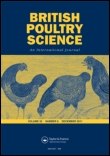Microsoft word - pfizer short paper.docx
Use of Life Cycle Assessment in Evaluating Solvent Recovery Alternatives in Pharmaceutical Manufacture William A. Carole, C. Stewart Slater, Mariano J. Savelski*, Timothy Moroz, Anthony Furiato, Kyle Lynch Rowan University, Dept. of Chemical Engineering 201 Mullica Hill Rd., Glassboro, NJ 08028, USA Keywords: pharmaceutical manufacture, solvent recovery, pervaporation, life cycle asse
 This article was downloaded by: [UNAM Ciudad Universitaria]On: 14 February 2013, At: 11:09Publisher: Taylor & FrancisInforma Ltd Registered in England and Wales Registered Number: 1072954 Registered office: MortimerHouse, 37-41 Mortimer Street, London W1T 3JH, UK
British Poultry Science
This article was downloaded by: [UNAM Ciudad Universitaria]On: 14 February 2013, At: 11:09Publisher: Taylor & FrancisInforma Ltd Registered in England and Wales Registered Number: 1072954 Registered office: MortimerHouse, 37-41 Mortimer Street, London W1T 3JH, UK
British Poultry Science